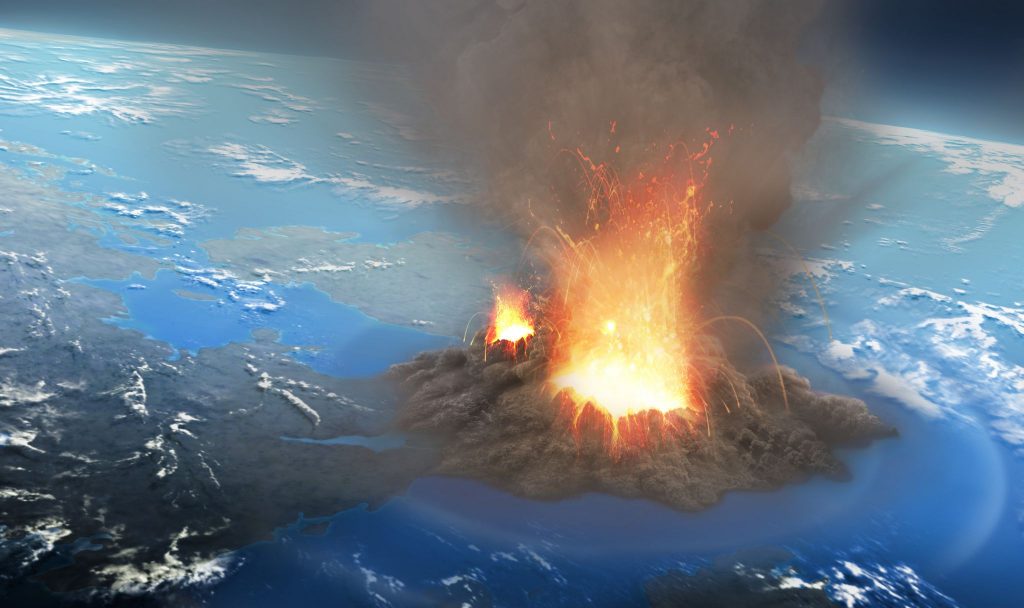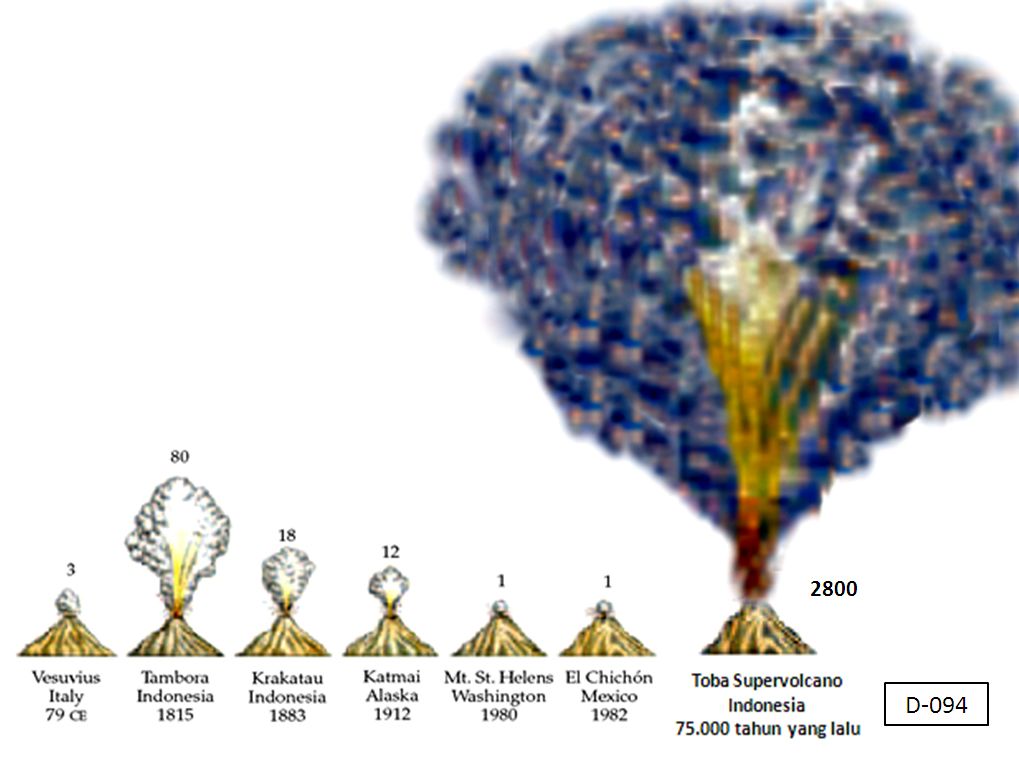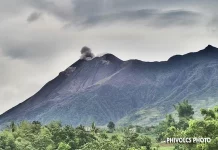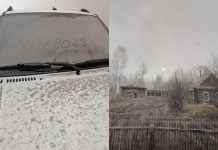
Imagine a year in the world that summer never arrives. The sky takes on a gray hue during the day and glows red at night. Flowers do not bloom. Trees die in the winter. Then, this same disheartening cycle repeats itself, year after year.
This is a picture of life on earth after the eruption of the super-volcano, Mount Toba in Indonesia, about 74,000 years ago.
Now, a new study suggests that catastrophic supervolcano eruption – one that would result in a global death toll – is much more likely than previously believed.
The research adds that there are around 20 such volcanoes that scientists had believed to be semi-dormant but which may in fact pose an extreme risk.
What are supervolcanoes?
The term “supervolcano” implies a volcanic center that has had an eruption of magnitude 8 on the Volcano Explosivity Index (VEI), meaning that at one point in time it erupted more than 1,000 cubic kilometers (240 cubic miles) of material.
In the early 2000s, the term “supereruption” began being used as a catchy way to describe VEI 8 eruptions. Explosive events of this size erupt so much magma that a circular-shaped collapse feature, called a caldera, forms above the evacuated magma storage region.
The largest (super) eruption at Yellowstone (2.1 million years ago) had a volume of 2,450 cubic kilometers. Like many other caldera-forming volcanoes, most of Yellowstone’s many eruptions have been smaller than VEI 8 supereruptions, so it is confusing to categorize Yellowstone as a “supervolcano.”
Other caldera-forming volcanoes that have produced exceedingly large pyroclastic eruptions in the past 2 million years include Long Valley in eastern California, Valles Caldera in New Mexico, Toba in Indonesia, and Taupo in New Zealand. Taupo erupted 22,600 years ago and is the most recent supereruption on Earth (with a volume of about 1,130 cubic kilometers).
Additional volcanoes capable of producing supereruptions include the large caldera volcanoes of Japan, Indonesia, and South America.
Enhanced risk of catastrophic supervolcano eruptions
Until now, it had been widely thought that the likelihood of a blow-out was dependent on the presence of liquid magma under a volcano.
But the new research found evidence that eruptions can occur even if no liquid magma is found.
If correct, it means that some supervolcanoes previously thought to have the potential to be dangerous only in the future could in fact be highly hazardous to humankind right now.
“The concept of what is ‘eruptible’ needs to be re-evaluated,” said associate professor Martin Danisik from Curtin University in Australia.
The team came to their conclusion after investigating what happened after the Lake Toba super-eruption some 75,000 years ago in what is today Indonesia.
The event itself is said to have caused a years-long global winter, which shrank the human population at the time to as few as 3,000 people.
But it is the fact that magma appears to have continued oozing for up to 13,000 years afterwards that has especially interested scientists – because it may suggest that eruptions can occur without the presence of liquid magma in the first place.
Professor Danisik said: “Super-eruptions are among the most catastrophic events in Earth’s history, venting tremendous amounts of magma almost instantaneously. They can impact global climate to the point of tipping the earth into a ‘volcanic winter’, which is an abnormally cold period that may result in widespread famine and population disruption.
“Learning how supervolcanoes work is important for understanding the future threat of an inevitable super-eruption.”
He added: “While a super-eruption can be regionally and globally impactful, and recovery may take decades or even centuries, our results show the hazard is not over with the super-eruption and the threat of further hazards exists for many thousands of years after.
“Learning when and how eruptible magma accumulates, and what state the magma is in before and after such eruptions, is critical for understanding super-volcanoes.”
Mount Tambora eruption in 1815
An eruption a hundred times smaller than Mount Toba – that of Mount Tambora, also in Indonesia, in 1815 – is thought to have been responsible for a year without summer in 1816. The impact on the human population was dire – crop failures in Eurasia and North America, famine and mass migrations.
The effect of Mount Toba, a super-volcano that dwarfs even the massive Yellowstone eruptions of the deeper past, would have had a much larger, and longer-felt, impact on people around the globe.

The scale of the ash-fall alone attests to the magnitude of the environmental disaster. Huge quantities of aerosols injected high into the atmosphere would have severely diminished sunlight – with estimates ranging from a 25 to 90 percent reduction in light.
Under these conditions, plant die-off is predictable, and there is evidence of significant drying, wildfires and plant community change in East Africa just after the Toba eruption.
If Mount Tambora created such devastation over a full year – and Tambora was a hiccup compared to Toba – we can imagine a worldwide catastrophe with the Toba eruption, an event lasting several years and pushing life to the brink of extinctions. [Nature, Independent]
We are clearly unprepared for the next mega eruption… And for the loudest sound on Earth…
Now subscribe to this blog to get more amazing news curated just for you right in your inbox on a daily basis (here an example of our new newsletter).
You can also follow us on Facebook and/ or Twitter. And, by the way you can also make a donation through Paypal. Thank you!
You should really subscribe to QFiles. You will get very interesting information about strange events around the world.














There’s no real way to prepare for a super volcanic eruption, like Toba. I can’t think of any. Since it reduces population so drastically, that would be a likely be a possible avenue of attack for the depopulation agenda satanists?
https://humansarefree.com/2021/09/pfizer-covid-pill-alongside-vaccines.html
Probably be good if a volcano formed under Pfizer H.Q. No question these assh0lers are satanic abominations.
https://www.newstarget.com/2021-09-05-red-cross-warning-covid-vaccinated-ineligible-donating-plasma.html
Red cross can’t use blood from vaxed people. Ha!
Doesn’t take a rocket scientist to see what’s happening here. All you vaxed people are a plague now. Enjoy yourselves, and keep pumping the vax booster plague into your body.
Lemmings —lolollolllollllolllll
I read thay those HARP can trigger volcanoes. Wouldn’t surprise me in the least either. I hate volcanoes too!
https://humansarefree.com/2021/09/top-fbi-arrested-for-sex-crimes-against-children.html
All our sacred institutions are infiltrated by pedosatanists! Good Lord, it’s time for divine justice. Smite ’em all with lightning bolts in the testicles!
Amen
https://www.thegatewaypundit.com/2021/09/racist-facebook-slammed-social-media-giant-compares-black-men-primates/
Yeah, well mark zukerswine has a volcano under his butt. Blames AI. Who programmed the AI?
See how these demon worshipping bigots work? Always pointing the finger at something else, with three fingers pointed back at them!
Disgraceful and unacceptable!
https://www.thegatewaypundit.com/2021/09/day-history-democrats-murder-4-former-slaves-5-republicans-clinton-ms-picnic-go-slaughter-another-50-100-blacks-following-week/
This day in history report. Well, democratic satanists—what do you have to say for yourselves?
See, you idiots are the problem!